
In 2024, Step-by-Step Tutorial How To Bypass Xiaomi Redmi 13C FRP

Step-by-Step Tutorial: How To Bypass Xiaomi Redmi 13C FRP
Smartphones are now integral to people’s daily lives. In recent days Xiaomi Redmi 13C has gained immense popularity. It is due to the Xiaomi Redmi 13C device’s impressive features and affordability. The rising cybercrimes have forced manufacturers to increase measures for device security. One such security feature is the Factory Reset Protection (FRP) on the Xiaomi Redmi 13C. It is designed to safeguard the Xiaomi Redmi 13C device from unauthorized access.
While this feature has its advantages, it can pose a significant challenge when users. This is especially the case when they need to perform a factory reset but have forgotten their Google account credentials. In this comprehensive tutorial for 2023, we will guide you step by step on how to bypass the Xiaomi Redmi 13C FRP.
Part 1: Understanding the Xiaomi Redmi 13C FRP
Having a clear understanding of what exactly Xiaomi Redmi 13C FRP entails is important. It will make the process of the Xiaomi Redmi 13C FRP bypass easier and hassle-free. In this section, we will explore the concept of FRP, its purpose, and how it is activated on the Xiaomi Redmi 13C:
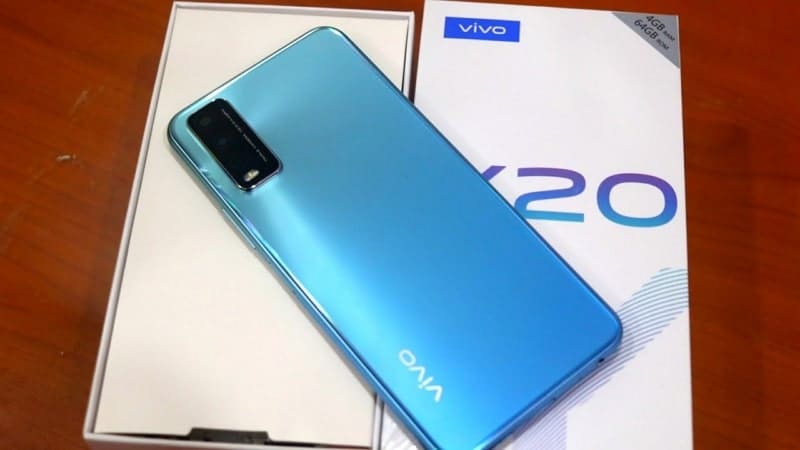
What is Xiaomi Redmi 13C FRP?
FRP, or Factory Reset Protection, is a security feature integrated into Android devices. It is also included on the Xiaomi Redmi 13C by Google to prevent unauthorized access to the Xiaomi Redmi 13C device. When FRP is activated on a smartphone, it links the Xiaomi Redmi 13C device to the user’s Google account.
That makes it mandatory to verify the account credentials after performing a hard reset. In other words, FRP acts as a protective barrier. It ensures only the rightful owner can access the Xiaomi Redmi 13C device.
Purpose of Xiaomi Redmi 13C FRP
The primary purpose of Xiaomi Redmi 13C FRP is to safeguard personal data and sensitive information stored on the Xiaomi Redmi 13C device. It works as an important security measure in the unfortunate event of the Xiaomi Redmi 13C device being lost or stolen. FRP ensures that no unauthorized individual can gain access to the Xiaomi Redmi 13C device’s contents. It does that by requiring the original owner’s Google account login details.
By requiring the user’s Google account credentials, FRP reduces the chances of device misuse. Thus, it ultimately enhances the data security and privacy of your device.
Activation Methods of Xiaomi Redmi 13C FRP
When you register a Google account on your device, the FRP gets activated automatically. If you remove the Google account from the Xiaomi Redmi 13C device before performing a factory data reset, the FRP will be disabled. However, once the FRP is enabled, it will stop you from using your Xiaomi Redmi 13C after a factory data reset in an untrusted environment.
In simple words, any other way to factory reset the Xiaomi Redmi 13C device except factory reset through settings will trigger FRP lock. A command example of this is a hard factory reset which usually enables FRP lock after the process.
Part 2: Preparations Before Bypassing Xiaomi Redmi 13C FRP
Now that you have a comprehensive understanding of the Xiaomi Y12 FRP bypass, it’s time to prepare for the bypassing process. This section will cover crucial preparations to ensure a successful FRP bypass . By following these steps, you can avoid potential failures:
1. Important Notes and Warnings
Before proceeding with the Xiaomi Redmi 13C FRP bypass, there are some essential things to keep in mind:
- Legal and Ethical Use: It is crucial to emphasize that bypassing FRP should only be done on devices that you own. Engaging in unauthorized bypassing FRP for illegal purposes may lead to legal consequences.
- Warranty Void: Bypassing FRP may void the warranty of your device. If your Xiaomi Redmi 13C is still under warranty, consider contacting the manufacturer or authorized service center for help.
- Security Risks: Bypassing FRP can potentially expose your device to security risks. Only follow trusted guides and sources to avoid installing malicious software.
2. Required Tools and Equipment
To bypass Xiaomi Redmi 13C FRP, you will need the following tools and equipment:
- A desktop computer or laptop with strong internet connectivity.
- A USB cable to connect your Xiaomi Redmi 13C to the computer.
- Access to third-party software for bypassing FRP.
3. Backup Your Data
If you have recently bought a used Xiaomi Redmi 13C and don’t know the Google account credentials, it can trigger FRP on factory reset. Before factory resetting your device, it is essential to back up the data. Since the Google account on your device doesn’t belong to you, you will need to use third-party tools to create local backups.
The best tool in this scenario to use is Wondershare Dr.Fone . With the help of this tool, you can back up the entire data of your Xiaomi Redmi 13C to your computer.
4. Ensure a Stable Internet Connection
A stable and reliable internet connection is vital for a smooth FRP bypass. Make sure your computer and Xiaomi Redmi 13C are connected to the internet throughout the process. FRP bypassing will need you to download related files to complete the procedure.
Part 3: Step-by-Step Guide: How To Bypass Xiaomi Redmi 13C FRP
With the necessary preparations, it’s time to embark on the step-by-step guide for the Xiaomi Y15 FRP bypass. This section will explore three different methods for bypassing FRP. The first method involves using your Google account credentials, the official way to bypass FRP:
Method 1: Using Google Account Credentials
Before attempting this method, ensure that you have access to the Google account associated with your Xiaomi Redmi 13C. If you’ve forgotten your account details, use Google’s account recovery options before proceeding. Here’s how to bypass Xiaomi Redmi 13C FRP using your Google account credentials:
- Step 1: Power on your Xiaomi Redmi 13C and choose the desired language. Afterward, connect your phone to a stable Wi-Fi network. Next, proceed through the Xiaomi Redmi 13C device setup until you reach the FRP verification screen.
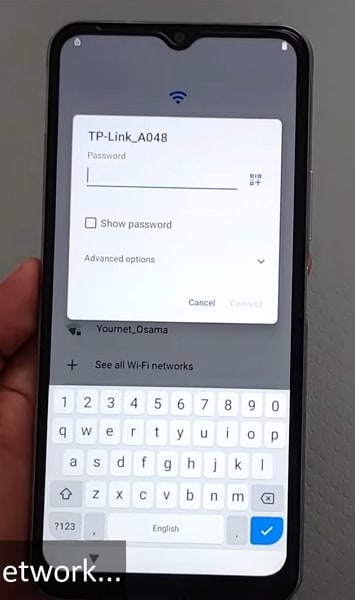
- Step 2: When prompted to verify your Google account, enter the associated email address and password. Ensure that you have a working and high-speed Wi-Fi connection during this step.
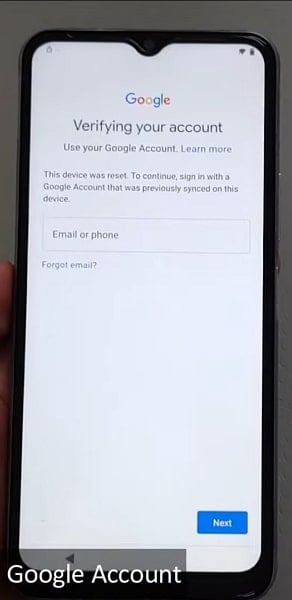
- Step 3: After entering the correct Google account credentials, the Xiaomi Redmi 13C device will verify the information. If the details are correct, FRP will be bypassed, and you will gain access to your Xiaomi Redmi 13C.
Method 2: Using FRP Bypass Tools
To bypass the FRP on Xiaomi Redmi 13C, you can utilize a specialized tool designed for this purpose. One highly recommended tool is Wondershare Dr.Fone . It is known for its reliability in bypassing FRP locks on various Android devices. This tool supports 15+ different brands with 2000+ Android devices for FRP bypassing.
Apart from bypassing the FRP lock, this tool is also an expert in unlocking other device locks. These include PIN, pattern, password, fingerprint, and face locks. With the help of this tool, you can unlock Samsung and LG devices without data loss. Here are the step-by-step instructions to perform the Xiaomi Redmi 13C FRP bypass:

Dr.Fone - Screen Unlock (Android)
The Best UnlockJunky Alternative to Bypass FRP and Solve Your Screen Locks
- Completely unlinked from the previous Google account, it won’t be traced or blocked by it anymore.
- Remove all Android screen locks (PIN/pattern/fingerprints/face ID) in minutes.
- Almost all Samsung phones and tablets are supported (Currently for Android 6-13).
- Provide specific removal solutions to promise good success rate.
4,008,672 people have downloaded it
- Step 1: Access Screen Unlock in Wondershare Dr.Fone
Start by installing Wondershare Dr.Fone on your computer, then launch the application. Afterward, navigate to the “Toolbox” tab and select “Screen Unlock.” Follow it by clicking on “Android” on the next screen. Choose “Remove Google FRP Lock” among the available options for screen unlocking.

- Step 2: Select Remove Google FRP Lock To Proceed
On the following screen, select “Vivo” as the targeted phone brand and click “Start.” Wondershare Dr.Fone will now download the necessary driver required for Xiaomi Redmi 13C FRP bypassing.
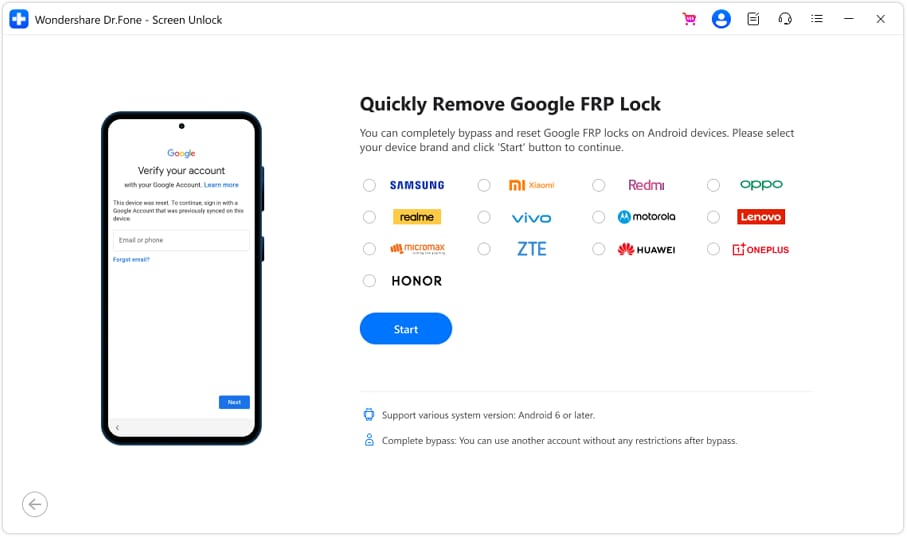
- Step 3: Complete the Xiaomi Redmi 13C FRP Bypass Process
Once the driver download is complete, turn off your Xiaomi Redmi 13C smartphone. Now, connect the turned-off device to your computer while simultaneously pressing both volume keys for at least 3 seconds. This action will trigger the FRP bypass process, which should take a few minutes to complete.
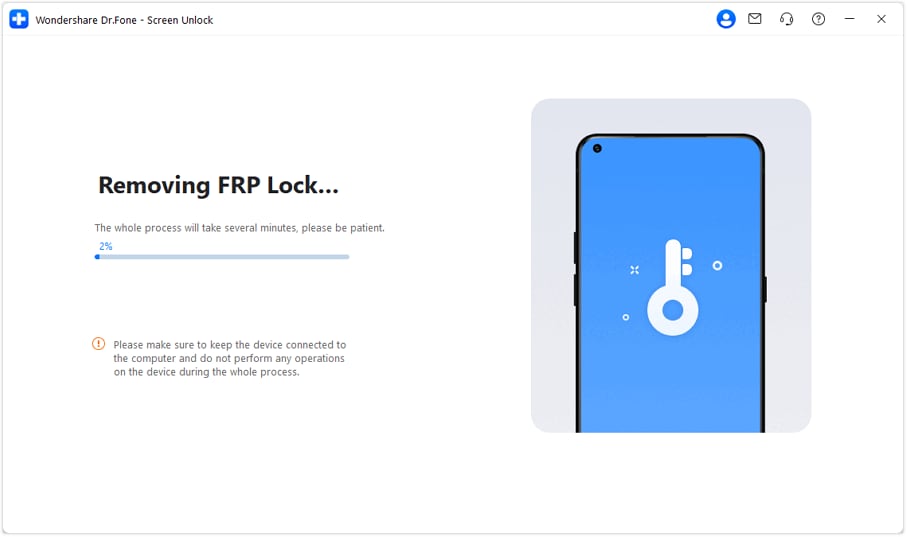
Method 3: Using Combination File
The third method on the list for Xiaomi Redmi 13C FRP bypass is using a combination file. In this method, you will need to use a specialized tool to bypass the FRP lock by putting your Xiaomi Redmi 13C phone into Recovery Mode. The detailed steps for this method are following:
- Step 1: Begin by downloading the Xiaomi FRP unlock tool (Password: GADGETSDOCTOR) on your computer and extract it. Now run the .exe file from the extracted content to install it. Afterward, turn off your Xiaomi Redmi 13C and put it into Recovery Mode.
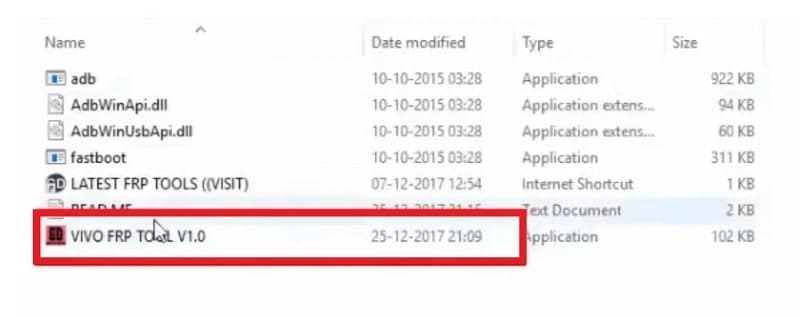
- Step 2: To put Xiaomi Redmi 13C into Recovery Mode, you will need to simultaneously press and hold the “Power” and “Volume Up” keys together. Hold these keys until you see Fastboot Mode on the screen. Here use the Volume keys to select Recovery Mode.
- Step 3: Within Recovery Mode, select “Advanced Options,” and on the following screen, choose “Reboot with adb.” Now wait for your phone to turn on and later connect it to the computer with FRP unlock tool installed.
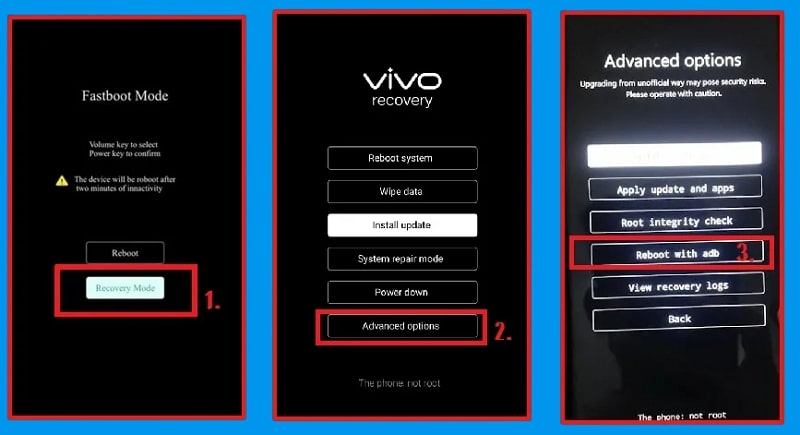
- Step 4: On the Xiaomi FRP lock tool interface, tap any key and press enter to check if your device is properly connected. Now repeat the process once again and wait for your Xiaomi Redmi 13C to reboot. Once the rebooting process is completed, check to confirm if the FRP lock has been bypassed.
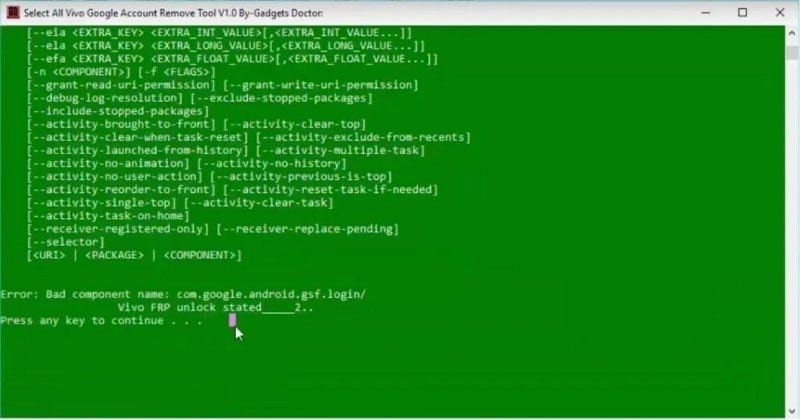
Part 4. Troubleshooting and Tips
Navigating the workings of the Xiaomi Redmi 13C FRP bypass can be challenging. As with any security feature, FRP is designed to protect your data and device. It makes the bypassing process a delicate task. This part will address common issues faced during FRP bypass attempts.
It will also offer valuable tips to ensure a successful process. Moreover, it will explore alternative methods should the initial approaches prove unsuccessful.
Common Issues Faced During Bypassing Xiaomi Redmi 13C FRP
- Incorrect Google Account Credentials: One of the most common issues during FRP bypass is entering incorrect Google account credentials. Double-check the email address and password associated with the Xiaomi Redmi 13C device.
- Unstable Internet Connection: A stable internet connection is crucial during the FRP bypass process. Ensure your device is connected to the internet throughout the procedure and it is not unstable.
- Outdated Software: Using outdated or incompatible tools may result in unsuccessful bypass attempts. Always ensure you are using the latest version of the tool or method.
- Device Compatibility: Not all bypass methods are universally compatible with all Android devices. Ensure that the method you choose is intended for use with the Xiaomi Redmi 13C.
Tips To Ensure a Successful Bypass Process
- Back-Up Data: Before attempting any bypass method, back up your important data because it will prevent accidental loss during the process.
- Verify Official Methods: Always focus on official methods, such as using Google account credentials. They are better than third-party tools or combination files.
- Use Reputable Sources: If you opt for alternative tools or methods, download them from reputable sources. It will help you avoid malware or security risks.
- Read User Reviews: If using third-party tools, read user reviews and forums. This will help you gauge their effectiveness and safety.
- Follow Instructions Carefully: Whether using official methods or alternative tools, follow instructions diligently to avoid mistakes.
Alternative Methods or Tools if the Initial Methods Fail
If the initial methods discussed in this article are failed to bypass the Xiaomi Redmi 13C FRP, then try these alternate methods to turn off the FRP lock:
1. Contact the Original Owner for Google Account Credentials
If you have bought the Xiaomi Redmi 13C in used condition and it is FRP-locked, try contacting the original owner. They might have the necessary account information to complete the verification process. In case they are able to provide you with Google account credentials, the process to bypass the Xiaomi Redmi 13C FRP lock becomes easy and quick.
2. Contact Xiaomi Customer Services
Have you tried various methods to bypass FRP on your Xiaomi Redmi 13C without success? It is the right time to contact professionals. Get in touch with Vivo’s official customer services or visit an authorized service center. They have the expertise to handle device-related issues, including FRP lockouts. Explain your situation to the support staff, and they will guide you through the appropriate steps to regain access.
Conclusion
In this comprehensive guide, we have explored various methods for the Xiaomi Redmi 13C FRP bypass. While there are several methods available, we highly recommend using the Wondershare Dr.Fone as the best choice. Dr.Fone is a reputable and reliable tool that offers a seamless and secure FRP bypass process.
It prioritizes data integrity and user privacy. Moreover, its clean interface ensures that even users with limited tech knowledge can use the bypassing process with ease.
Pangu FRP Bypass and Best Alternative Tool For your Android Device
Pangu FRP Bypass is a popular tool claiming to unlock Factory Reset Protection (FRP) on various Android phones. FRP is automatically enabled when you set up your Android device and link it to a Google account.
The FRP lock activates if someone tries to do a factory reset in an untrusted environment without removing the Google account. Without entering your Google credentials, you won’t be able to use your phone. It renders your phone useless for resale or personal use.
Then are you curious about the safety of the Pangu FRP bypass tool? What is this tool, and how does it work? If you have similar questions, this guide has the answers. Here, we’ll show you what you need to know about the bypass tool and alternative software.

Part 1: What Is Pangu FRP Bypass Tool?
FRP is a security feature implemented by Google on Android devices running Lollipop (5.1) and later. It ties your Google account to the Xiaomi Redmi 13C device, requiring you to enter the account credentials after a factory data reset. The FRP lock discourages phone theft and protects your data.
The Pangu FRP Bypass tool aims to get around the FRP lock. It grants you access to your device without needing the Google account credentials. The tool uses the loopholes or flaws in the security system to gain access and disable FRP.
The tool can be helpful in situations where you:
- Forgot your Google account credentials
If you can’t remember your Google account password, Pangu FRP unlocker can help you bypass the verification and access your device.
- Bought a used phone
If you purchased a used phone with a previous owner’s Google account linked, the Pangu FRP tool can help you remove that account and set up your own.
- Need to reset your phone but don’t want to lose access
If you need to factory reset your phone but don’t want to lose access to your Google account, it can help you bypass the FRP after the reset.

How Does It Work?
There are two main versions of Pangu FRP Bypass tools:
- Pangu FRP Bypass APK
This app is downloaded and installed on the FRP-locked device. It directs you through steps, using weaknesses to reach hidden settings. By doing so, the Pangu FRP Bypass APK removes the FRP lock, allowing access to the home screen.
- Pangu FRP Bypass Tool for PC
This software runs on your computer and requires connecting your device via USB. It then performs similar operations to the APK version. That is using the computer connection to control the Xiaomi Redmi 13C device’s system and bypass the FRP lock.
Is It Legal?
The legality of using the Pangu FRP Bypass remains a gray area. While it’s not inherently illegal, using it for purposes like accessing stolen devices is unlawful. Use it responsibly and ethically.
Part 2: What Are the Supported Brands for the Pangu FRP Bypass Tool?
The Pangu FRP Bypass boasts extensive compatibility with several Android brands, covering:
- Samsung
- Lenovo
- LG
- Oppo
- HTC
- Micromax
- Vivo, and more

Different devices and Android OS versions may have varying compatibility within each brand. That includes Oreo, Marshmallow, and Nougat. Some older or newer models may not support the Pangu FRP Bypass APK, even though it works well on many models. Its file size can also differ based on the version you download.
Part 3: How To Download and Install Pangu FRP Bypass APK?
Before downloading the APK file, you’ll need a USB drive and an OTG cable to connect your Android device to your PC. Once you have these ready, you can move on to the installation steps. Follow the steps below to download and install the Pangu FRP Bypass on your Android phone.
- Step 1: Download the tool’s APK from a trusted source. You can get it from the Pangu official website, if available.

- Step 2: Copy the downloaded tool to a USB drive using a computer.
- Step 3: Connect the USB drive to your FRP-locked Android phone using an OTG cable.
- Step 4: Open the file manager on your Android device, locate the Pangu FRP Bypass APK on the USB drive, and install it. If you encounter issues, proceed to the next steps.
- Step 5: Open the Google Play Store app, then tap the profile icon at the upper-right corner.
- Step 6: Go to Play Protect, then tap the Settings icon at the upper-right side of the screen.

- Step 7: Toggle off the Scan apps with Play Protect option and tap Turn off on the dialogue box. This setting allows the installation of apps from outside the Google Play Store.

Part 4: How To Use Pangu FRP Unlocker on Android?
Before you start, ensure you have permission to unlock the FRP on the Android device. Also, check your internet connection, have enough phone charge, and a backup of your phone data. Now, follow these steps to use Pangu and remove the Google account FRP lock on your phone:
- Step 1: Launch the Pangu FRP bypass on your phone and tap the menu icon in the top right.

- Step 2: Follow the on-screen guide to detect and unlock your device.
- Step 3: Tap the browser sign-in icon and enter a new Google Mail ID. Then, press Next to continue.
- Step 4: Create a password you can remember in the future. Once satisfied, tap the Finish icon to proceed.
- Step 5: Wait for your details to upload. Once completed, restart your Android phone with the designated key combination.
- Step 6: On the Google Mail account page, enter the profile details you created and tap Next. Your device will show, “FRP is trying to accept Gmail + password.“
Part 5: Is Pangu FRP Bypass the Best FRP Removal Tool for You?
Pangu FRP bypass tool is free and works on older Android versions. But there are reasons to consider other options. Let’s explore them.
Technical Knowledge Required
It can be a bit complex to use for some users, especially if you’re not tech-savvy. Using it involves downloading and installing APKs, which can be risky and time-consuming. It’s not as beginner-friendly as some alternatives in the market.
Limited Customer Support
Thetooldoesn’t provide official support via live chat or phone. This leaves you without direct help if issues arise during the bypass process. Depending on online forums for troubleshooting can be time-consuming and unreliable.
Limited Compatibility
Pangu FRP bypass is primarily focused on Samsung devices and may not work on the latest Android brands or versions. Also, it needs an OTG cable and USB drive, making it less convenient. Consider FRP bypass alternatives for broader compatibility and ease.

Safety Concerns
Some Pangu FRP bypass APK versions have been flagged as potentially containing malware or viruses. While this isn’t always the case, it’s crucial to be cautious and download the tool from a trusted source.
Low Success Rate
While the bypass tool can sometimes be effective, its success rate isn’t guaranteed. It can be frustrating if you go through the entire process only to find it didn’t work on your device. Choosing other FRP bypass software with a higher success rate can save you time.
Choosing between Pangu and an alternative depends on your needs and tech skills. If you’re comfortable with downloading APK, Pangu can work. But if you prefer ease of use, broader device compatibility, and safety, consider dedicated tools like Wondershare Dr.Fone - Screen Unlock (Android).
Part 6: Wondershare Dr.Fone - Screen Unlock for Android: Best Alternative to Pangu
Dr.Fone is one of the best alternative tools for Pangu FRP bypass. With its user-friendly and intuitive interface, you can effortlessly remove the FRP lock in several steps. Dr.Fone is a reliable choice to bypass Google FRP on Android, even if you don’t have a Google account or PIN code. Dr.Fone - Screen Unlock can bypass FRP and is compatible with Samsung, Vivo, Realme, Oppo, Redmi, and Xiaomi Android phones.
Aside from that, it can also do the following:
- Remove four types of lock screens: pattern, PIN, fingerprint, and password.
- Unlock your lock screen without erasing your data so you can access your phone.
How To Use Dr.Fone - Screen Unlock To Bypass Google FRP?
If your Android OS is version 14 or below, Dr.Fone can help you eliminate the FRP lock on Android in a few minutes. Download the app, launch it on your computer, and follow the steps below.
- Step 1: Connect your phone to your desktop using a USB cable, then select Screen Unlock from the Toolbox homepage.

- Step 2: Select Android as your device type to continue the FRP bypass process.

- Step 3: Select Remove Google FRP Lock on the next screen.

- Step 4: Select your phone brand from the list of supported brands, then click Start to proceed.

- Step 5: Follow the next in-app instructions, which may vary based on the brand of your Android device.
- Step 6: Wait while Dr.Fone removes the FRP lock on your phone.
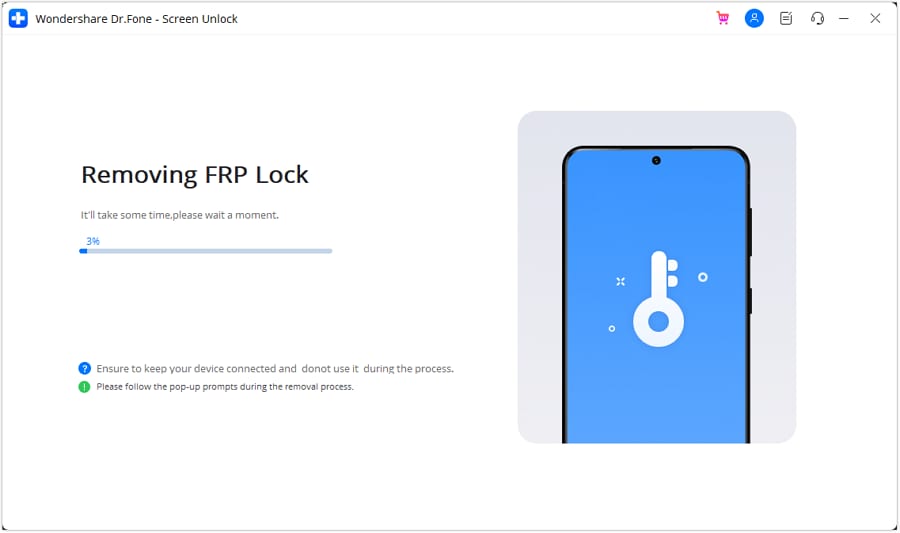
- Step 7: Click Done to confirm successful FRP bypass or click Try Again to repeat the process (available for Samsung devices.)
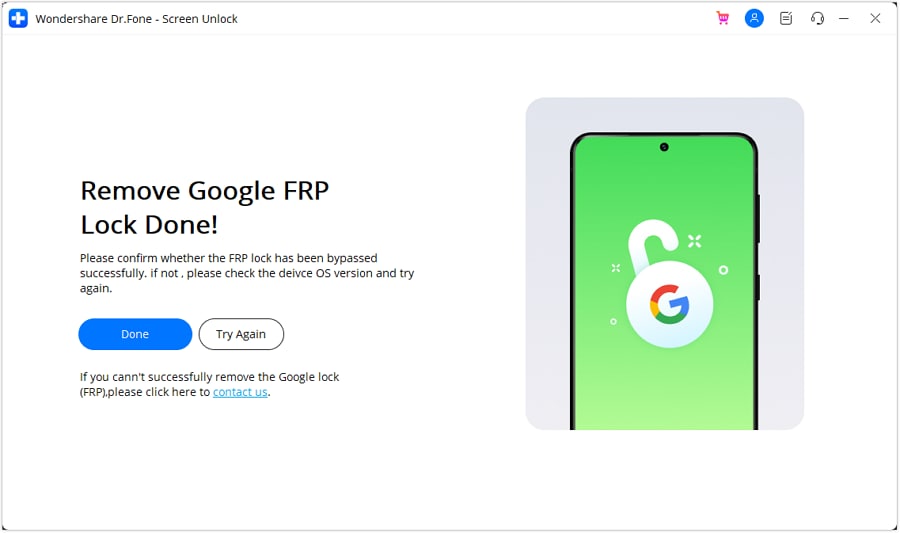
Conclusion
Bypassing FRP on Android can be challenging. Downloading APK tools like Pangu FRP Bypass may be unreliable and risky. They often lack support for newer devices and have an inconsistent success rate.
Wondershare Dr.Fone offers an easier, faster, and user-friendly solution for bypassing FRP on almost all Android models, regardless of their version. Its intuitive interface and high success rate empower you to regain access to your devices. Don’t let a locked screen stand in the way of your data. Explore Dr. Fone’s Screen Unlock (Android) tool for a reliable solution to future FRP-lock issues.
Tips: Searching for a powerful FRP bypass tool? No worries as Dr.Fone is here to help you. Download it and start a seamless unlock experience!
A Step-by-Step Guide on Using ADB and Fastboot to Remove FRP Lock on your Xiaomi Redmi 13C
Factory Reset Protection is one of the security measures available on Android 5.1 and later devices to prevent intruders’ unauthorized factory resetting of the Xiaomi Redmi 13C device. Among the several ways to fix this issue and remove the lock, one is ADB and Fastboot commands. So, if you are aware of using Android Debug Bridge, the below content will help you understand how it can be used to remove the FRP lock.
You can watch the video below to bypass FRP lock without hassle!
Part 1: Quick Overview of ADB and Fastboot Commands
1. What are ADB and Fastboot?
Standing for Android Debug Bridge, ADB and Fastboots are the methods through which communication with an Android device can be done through a computer. Under this method, the commands and the actions that are sent from the system are performed on your Android device.
Several issues can be resolved, and multiple functions can be performed using the ADB format tool and Fastboots, and this also includes removing the FRP lock on your Android device. To use this method, USB debugging should be enabled on the Xiaomi Redmi 13C device.
For specific brands of Android phones, specific utility tools are available like the Vivo ADB format tool and the Samsung ADB format tool, which are used explicitly for Vivo and Samsung phones, respectively.
2. How Do ADB and Fastboot Bypass FRP?
Using the versatile ADB command-line tool and Fastboots, the Google FRP lock can be removed using several commands depending on the OS version. This is a client-server program that includes a client who sends the commands, a daemon used to run the commands on the Xiaomi Redmi 13C device, and a server that facilitates communication between the client and the daemon.
ADB comes included in the Android SDK Platform-Tools package, and this can be downloaded using the SDK manager.
3. What Are the Android Versions that ADB and Fastboot Command Support?
The Android versions on which ADB and Fastboot commands can be used are as follows:
_Android 5 – Lollipop__Android 6- Marshmellow__Android 7 – Nougat__Android 8- Oreo__Android 9- Pie__Android 10 – Q (expected to work though not tested as yet)_
Part 2: How to Set Up ADB and Fastboot Commands to Remove FRP Lock on Android?
To remove FRP lock using ADB, you first need to install and set up ADB and then remove them using the command. The steps for the same are enlisted below.
Steps to remove FRP using ADB

Step 1. Firstly, download the ADB installed setup file and then extract the files from the toolkit on your system in a folder.
Step 2. Next, you need to run adb.setup.exe and then type Y for installing the drivers for ADB and Fastboot.
Step 3. Again, enter Y for installing the drivers and when done successfully, the command window will close.
Step 4. Next, power on your Android device and connect it to your PC using a USB cable. Here also ensure that USB debugging mode is enabled on your Android device.
Step 5. Next, hold down the Shift key and then right-click at any place blank in the ADB folder, and then choose the Open command window here option.
Step 6. Now to remove the FRP you need to enter the following commands at the command prompt one by one where enter needs to be clicked after every line.
_Adb shell am start -n com.google.android.gsf.login/__adb shell am start -n com.google.android.gsf.login.LoginActivity__adb shell content insert –uri content://settings/secure –bind name:s:user_setup_complete –bind value:s:1_Step 7. The above commands are for Samsung devices. If you want to remove the FRP on other brands, enter the following commands:
_Adb shell content insert –uri content://settings/secure –bind__name:s:user_setup_complete –bind value:s:1_

After the execution of the commands, the FRP lock will be removed from your Android device.
Steps to remove FRP using Fastboot
Step 1. Put the Android device into the bootloader or fastboot mode. (depending on the model and brand of your Android device, the process of entering into the fastboot will differ).
Step 2. Connect your phone to your PC using a USB cable.
Step 3. Next, depending on the system, enter the following command in the CMD window:
_Lenovo FRP command__fastboot erase config__fastboot reboot__XIAOMI FRP command__fastboot -w__MICROMAX YU YUPHORIA FRP__Fastboot -i 0x2a96 erase configFastboot -i 0x2a96 reboot__DEEP/HTC/Other Brands FRP__fastboot erase configfastboot reboot_
Part 3: Limitations of Using ADB and Fastboot Command Method
The ADB and Fastboots command is a workable solution for removing the FRP lock on your Android device, the drawback is that the method is quite complicated and requires thorough technical know-how of ADB and its working. There are several limitations associated with this method as enlisted below.
- Requires technical know-how
To remove FRP using the ADB command you need to have a thorough knowledge of using the tool. The tool has a deep learning curve which makes this method little for the majority of the users.
- Might not unlock the phone
You can try the ADB method for removing the FRP lock but there is no guarantee that the results will be positive and your device will be unlocked.
- Issues with the drivers
Several times while using this method, you might encounter driver issues when your device is not detected as proper drivers are not installed.
- Unexpected issues and errors
ADB is a command-based method, and thus it is important that the commands are entered right. If there is a slight error in the typing of the command, it might lead to major issues and can even be the Xiaomi Redmi 13C device damaged.
- The process is not user-friendly
ADB is a technical process aimed toward the geeks, and thus the overall process is not user-friendly and complicated.
Part 4: The Best ADB Alternative to Bypass FRP Lock on Android Phones
Considering the several limitations of the ADB and Fastboot command method, the need for a simple, user-friendly, and workable solution for removing FRP lock on Android devices arises. One of the best software here that we recommend is Dr.Fone - Screen Unlock (Android) which helps in removing and bypassing many Android phone screen locks including the one appearing due to FRP lock.
Dr.Fone - Screen Unlock (Android)
Remove Google FRP on Samsung without PIN code or Google accounts.
- Pattern, PIN, password, fingerprints & face screen lock can all be unlocked.
- Bypass Google FRP on Samsung without pin code or Google accounts.
- No tech knowledge asked, everybody can handle it.
- Work for Samsung, Xiaomi, Redmi, OPPO, etc.
4,005,551 people have downloaded it
The process of using the software is user-friendly and thus can also be used by non-techy users.
Steps for removing FRP lock on Android using Dr.Fone Screen Unlock
- Step 1. Launch the installed software and choose the Screen Unlock option from the main interface. Choose Android and then select the Remove Google FRP Lock option.

- Step 2. Select the model brans from the options shown on the interface, and then connect your phone to your PC using a USB cable. The connected device details will appear on the interface.

- Step 3. Follow the next steps as they appear. Once the FRP lock is successfully removed, the prompt window will show its completion. Click Done if you have successfully executed the process.

The above is the brief steps for the process. You can check the bypass Samsung FRP lock guide in detail.
Conclusion
If you are well versed with the commands of ADB and Fastboots you can go ahead and use the ADB bypass FRP tool for removing the FRP lock but if this command line method seems complicated for you, Dr.Fone Screen Unlock is the best tool to use.
Also read:
- [New] In 2024, Circumventing Video Send Blockages in Facebook Chat Apps
- [New] In-Depth Look at Lowest and Highest Priced Cloud Options, 2024
- Cloud Storage Pricing Comparison and Best Price Recommendations
- Easy Guide to Tecno Camon 30 Pro 5G FRP Bypass With Best Methods
- Effective Solutions for Resolving the 'Windows Update Error Code 0X80244022'
- Hassle-Free Ways to Remove FRP Lock on Honor 80 Pro Straight Screen Editionwith/without a PC
- How To Transfer WhatsApp From Apple iPhone XS to other iPhone 15 devices? | Dr.fone
- In 2024, 5 Quick Methods to Bypass Vivo Y100 5G FRP
- In 2024, A Step-by-Step Guide on Using ADB and Fastboot to Remove FRP Lock on your Realme 11X 5G
- New Light on the Sony S3700 Blu-Ray Reader Review
- Risk-Free Providers of Popularity Boosts on TikTok for 2024
- Top 5 Samsung Galaxy A05s Bypass FRP Tools for PC That Actually Work
- Title: In 2024, Step-by-Step Tutorial How To Bypass Xiaomi Redmi 13C FRP
- Author: Lynn
- Created at : 2025-01-22 17:23:11
- Updated at : 2025-01-24 19:48:12
- Link: https://bypass-frp.techidaily.com/in-2024-step-by-step-tutorial-how-to-bypass-xiaomi-redmi-13c-frp-by-drfone-android/
- License: This work is licensed under CC BY-NC-SA 4.0.